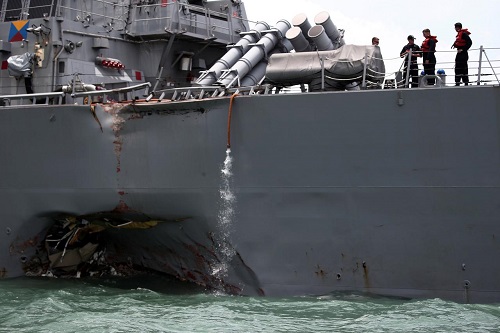Reuters photo
By
Ricardo Swire
On August 21st 2017 the US Navy guided missile destroyer USS John S. McCain (DDG-56), a member of Squadron 15’s Seventh Fleet, collided with a commercial vessel navigating east of Singapore. The occurrence in Asian waters triggered an American Government Accountability Office (GAO) probe. Investigators concluded the accident caused a gaping USS McCain hull puncture, death of ten American Navy sailors and injuries to five, he commercial vessel being extensively damaged.
A series of US Navy ship collisions raise serious questions about the fleet’s operational safety. Especially since functional Aegis Ballistic Missile Defence (BMD) naval ships are critical to America’s protective umbrella covering Japan and South Korea. USS McCain’s collision with the Liberian flagged oil tanker was 2017’s fourth involving American warships traversing the Pacific Ocean. From his Yokosuka, Japan office the Vice Admiral managing US Seventh Fleet reported “USS McCain’s Commanding Officer and Executive Officer were relieved of duty and reassigned due to a loss of confidence.”
Seventeen US Navy sailors died in three incidents two months apart. During late January 2017 the USS Antietam (CG-54) guided missile ship ran aground in Tokyo Bay and damaged its propellers attempting to anchor. One thousand one hundred gallons of hydraulic fluid/oil leaked from the crippled US Navy ship in China’s coastal waters prompting high-level political attention. In May 2017 USS Lake Champlain (CG-57) collided with a seventy foot long Korean fishing boat navigating off the Korean Peninsula. USS Lake Champlain is officially assigned to the aircraft carrier USS Carl Vinson’s Strike Group.
On June 17th 2017 the USS Fitzgerald (DDG 62) guided missile destroyer struck a Philippine flagged cargo ship in Japan’s territorial waters. Seven US Navy sailors were killed and three injured. Thirty-five crew members occupied USS Fitzgerald’s sleeping quarters at the time of impact, twenty-five sailors escaped. GAO investigators flagged “Warfare Training Certification” expired in June 2017, for more than one third of Seventh Fleet’s destroyer and cruiser class ships. Such amount represents five times more than Seventh Fleet’s 2015 record.
Seventh Fleet is comprised of eighty Navy ships and submarines that symbolize America’s front-line maritime missile defence against North Korea. Activity patterns show US Navy ships stationed stateside spend forty percent of operational time deployed and sixty percent conducting training. Japan based US Navy ships deployed sixty-seven percent and maintained thirty-three percent. Such vessels have no registered training rosters.
The May 2015 GAO Report identified US Navy ships’ “overseas deployments” as main reason for limited training and lack of critical maintenance. American military protocol dictates Navy ships require at least twelve training certifications raging from mobility, seamanship, ballistic missile defence to surface warfare capabilities. The document pinpointed Japan based US naval vessels without dedicated training periods. Between 2009 and 2014 US Navy ship reports of “worn” or “out-of-service” equipment doubled.
From June 2017 eight of eleven US Navy destroyers and cruisers aka “surface warfare ships” stationed in Japan operated with expired mobility, seamanship, air and underwater warfare certifications. September 2017 Squadron 15 data reflected several times before each accident USS McCain and Fitzgerald failed to fulfil mandatory training. Documentary evidence identified senior US Naval Officers who issued waivers to counter expired certifications, guaranteeing ships remained on patrol. Such situation compounded by maintenance backlogs and mechanical parts shortages.
Ricardo Swire
Ricardo Swire is the Principal Consultant at R-L-H Security Consultants & Business Support Services and writes on a number of important issues.



No Comments Yet!
You can be first to comment this post!